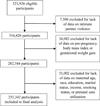Intimate Partner Violence and Gestational Weight Gain in a Population-Based Sample of Perinatal Women
- PMID: 28294945
- PMCID: PMC5423819
- DOI: 10.1016/j.jogn.2016.12.003
Intimate Partner Violence and Gestational Weight Gain in a Population-Based Sample of Perinatal Women
Abstract
Objective: To examine the effects of intimate partner violence (IPV) at varied time points in the perinatal period on inadequate and excessive gestational weight gain.
Design: Retrospective cohort using population-based secondary data.
Setting: Pregnancy Risk Assessment Monitoring System and birth certificate data from New York City and 35 states.
Participants: Data were obtained for 251,342 U.S. mothers who gave birth from 2004 through 2011 and completed the Pregnancy Risk Assessment Monitoring System survey 2 to 9 months after birth.
Methods: The exposure was perinatal IPV, defined as experiencing physical abuse by a current or ex-partner in the year before or during pregnancy. Adequacy of gestational weight gain (GWG) was categorized using 2009 Institute of Medicine guidelines. Weighted descriptive statistics and multivariate logistic regression models were used.
Results: Approximately 6% of participants reported perinatal IPV, 2.7% reported IPV in the year before pregnancy, 1.1% reported IPV during pregnancy only, and the remaining 2.5% reported IPV before and during pregnancy. Inadequate GWG was more prevalent among participants who experienced IPV during pregnancy and those who experienced IPV before and during pregnancy (23.3% and 23.5%, respectively) than in participants who reported no IPV (20.2%; p < .001). Participants who experienced IPV before pregnancy only were significantly more likely to have excessive GWG (p < .001). Results were attenuated in the multivariate modeling; only participants who experienced IPV before pregnancy had weakly significant odds of excessive GWG (adjusted odds ratio = 1.14, 95% CI [1.02, 1.26]).
Conclusion: The association between perinatal IPV and inadequate GWG was explained by confounding variables; however, women who reported perinatal IPV had greater rates of GWG outside the optimal range. Future studies are needed to determine how relevant confounding variables may affect a woman's GWG.
Keywords: PRAMS; gestational weight gain; intimate partner violence.
Copyright © 2017 AWHONN, the Association of Women’s Health, Obstetric and Neonatal Nurses. Published by Elsevier Inc. All rights reserved.
Conflict of interest statement
Disclosure The authors report no conflict of interest or relevant financial relationships.
Figures
References
-
- Abeysena C, Jayawardana P. Sleep deprivation, physical activity and low income are risk factors for inadequate weight gain during pregnancy: A cohort study. The Journal of Obstetrics and Gynaecology Research. 2011;37(7):734–740. - PubMed
-
- ACOG committee opinion no. 518: Intimate partner violence. Obstetrics and Gynecology. 2012;119(2 Pt 1):412–417. - PubMed
Publication types
MeSH terms
Grants and funding
LinkOut - more resources
Full Text Sources
Other Literature Sources
Medical


